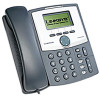Cisco SPA921-NA Administration Guide - Page 71
Dial Plan Rules, Digit Sequence Syntax, Element Repetition
 |
View all Cisco SPA921-NA manuals
Add to My Manuals
Save this manual to your list of manuals |
Page 71 highlights
Chapter 3 Managing Linksys 900 Series IP Phones Configuring a Dial Plan • An explicit "send" (user presses the # key)-The digit sequence is accepted and transmitted as dialed if incomplete, or transformed as according to the dial plan if complete. The time-out duration depends on the matching state. If no candidate sequences are as yet complete (as dialed), the Interdigit_Long_Timeout applies. If a candidate sequence is complete, but there exists one or more incomplete candidates, the applies. Table 3-5 describes the entries to use when programming the dial plan. Table 3-5 Dial Plan Entries Dial Plan Entry *xx [3469]11 0 00 [2-9]xxxxxx 1xxx[2-9]xxxxxx xxxxxxxxxx. Function Allows arbitrary 2-digit star code Allows x11 sequences (for example, 311, 411, 611, 911) Dials operator Dials international operator Dials US local number Dials US 1 + 10-digit long distance number Dials all other numbers, including international long distance Dial Plan Rules This section describes the rules that apply to configuring and interpreting dial plans. Note White space in a dial plan script is ignored, but it may be used for readability. Digit Sequence Syntax Each digit sequence within the dial plan consists of a series of elements, which are individually matched to the keys pressed by the user. Elements can be one of the following: • Individual keys 0, 1, 2 . . . 9, *, #. • The letter x matches any one numeric digit (0 .. 9) • A subset of keys within brackets (allows ranges): for example, [389] means 3 or 8 or 9) - Numeric ranges (n-n) are allowed within the brackets: for example, [2-9] means any digit from 2 through 9) - Ranges can be combined with other keys: e.g. [235-8*] means 2 or 3 or 5 or 6 or 7 or 8 or *. Element Repetition Any element can be repeated zero or more times by appending a period (.) to the element. Thus, "01." matches "0", "01", "011", "0111", ... and so on. Document Version 3.0 Linksys 900 Series IP Phone Administrator Guide 3-23















